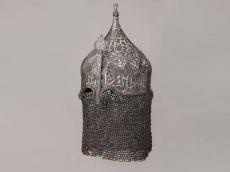|
|
TODAY.AZ / Arts & Entertainment
U.S. museum displays Shirvashah's helmet
19 January 2016 [17:29] - TODAY.AZ

By Amina Nazarli
The art specimens of Azerbaijani masters spread all over the world since ancient times and had gained repute with its artistic excellence and beauty. The national handicraft masters’ works can be met in museums around the world, including in the United States.
Hundreds of rare art specimens can be found in the museums of Washington, New York, Chicago, Los Angeles, Philadelphia, Houston, San Francisco, Cleveland, Detroit, Boston and other cities, art galleries and private collections.
Among the samples kept in the U.S. Metropolitan Museum of Art one can find also a turban helmet, belonging to Shirvanshah Farrukh Yashar, the last ruler of Azerbaijan’s state Shirvanshahs.
The helmet dates back to the late 15th century and is made from steel, silver, copper alloy.
This especially attractive and well preserved turban helmet retains the mail aventail that protected the lower half of the face and neck. The aventail is fixed with a lead seal stamped with the mark used in the Ottoman arsenals, an indication that this example, like the other turban helmets also in the Museum's collection, passed into Turkish possession as booty with the Ottoman conquest of Iran and the Caucasus.
Although the label of the showpiece depicts that the helmet was made for a ruler, the description mentions nothing about the belonging of the helmet to Azerbaijan.
The information about the helmet says that “At least one turban helmet decorated in a style comparable to this example bears the name of Farruhk-Siar (reigned 1464–1501), ruler of Shirvan in the Caucasus. Such evidence suggests that this helmet is also of Shirvan manufacture.”
In fact, the State of Shirvanshahs founded between Shabran and Gilgilchay was approximately existed 1,000 years. Shirvanshahs took important role in continuation and upgrade of Azerbaijan people's statehood traditions after the collapse of the Great Saldjuc emperorship. The current capital of Azerbaijan, Baku, was for the first time proclaimed the capital by Shirvanshahs in the 12th century.
Azerbaijani historian Sarah Ashurbeyli writes “In spite of the heroic struggle for independence for ten centuries, the Shirvanshahs state after 1538 virtually ceased to exist, it fell under the blows of the troops appeared on the historical scene of a strong Azerbaijani Safavid state, and there was not even a trace from this dynasty, except only a name.”
The Metropolitan Museum of Art, colloquially "the Met", located in New York City, is the largest art museum in the United States and among the most visited art museums in the world. Its permanent collection contains over two million works, divided among seventeen curatorial departments.
The museum keeps many exhibits belonging to Azerbaijani history and culture including national instruments, carpets, belts and others.
URL: http://www.today.az/news/entertainment/146899.html
 Print version
Print version
Connect with us. Get latest news and updates.
See Also
- 28 April 2025 [15:22]
Uzeyir Hajibayli's legacy highlighted at scientific and practical conference - 28 April 2025 [14:38]
Republican Youth Library presents virtual exhibition in honor of Academician Zarifa Aliyeva - 28 April 2025 [13:25]
Young opera stars shine at 2nd Fidan Hajiyeva's Int'l Opera Festival - 28 April 2025 [11:47]
Ganja State Philharmonic presents new project "The Power of Words" - 28 April 2025 [10:44]
Magical journey through centuries in Baku -opera time machine - 28 April 2025 [08:00]
Children's Art Festival qualifying round is underway - 27 April 2025 [21:17]
Culture Ministry: Enrollment for music and arts schools now open electronically - 27 April 2025 [18:00]
Azerbaijani delegation participates in Turkic World Cultural Forum - 27 April 2025 [13:43]
Carpet Museum to host Battle of Champion in Rapid and Blitz - 26 April 2025 [16:20]
Dubai hosts live solo exhibition by Azerbaijan’s 1st AI artist "Shusha"
Most Popular
 Pakistan warns of danger of "all-out war" as Kashmir crisis escalates
Pakistan warns of danger of "all-out war" as Kashmir crisis escalates
 Azerbaijan’s bold play: From Belt and Road passageway to global business hub [ANALYSIS]
Azerbaijan’s bold play: From Belt and Road passageway to global business hub [ANALYSIS]
 Azerbaijan and Pakistan FMs hold phone conversation on strategic partnership & regional security
Azerbaijan and Pakistan FMs hold phone conversation on strategic partnership & regional security
 Biophysics Institute holds scientific seminar
Biophysics Institute holds scientific seminar
 President Ilham Aliyev gives interview to China's CGTN television channel in Beijing
President Ilham Aliyev gives interview to China's CGTN television channel in Beijing
 US cuts cybersecurity aid to Ukraine, halts equipment deliveries
US cuts cybersecurity aid to Ukraine, halts equipment deliveries
 Dubai hosts live solo exhibition by Azerbaijan’s 1st AI artist "Shusha"
Dubai hosts live solo exhibition by Azerbaijan’s 1st AI artist "Shusha"
